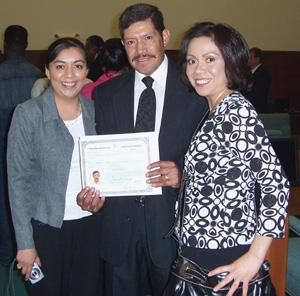
By Barb Arland-Fye
Dionicio Guerrero, a Mexican native, became a U.S. citizen May 1 in a ceremony two of his daughters, both employees of the Diocese of Davenport, had the privilege of witnessing.
The 55-year-old Guerrero has lived and worked in the Quad-City area for many years, but needed to learn to read and write before taking the citizenship test that all immigrants are required to pass before becoming naturalized citizens.
“I’m happy,” Guerrero said after the ceremony at the Federal Courthouse in Rock Island, Ill. “Being an American means to serve this country, to be able to vote and to travel with a U.S. passport,” his daughter, Esmeralda Guerrero, said. She is an administrative assistant in the Davenport Diocese’s Social Action Department. Her sister, Gricelda Garnica, also at the ceremony, is an immigration counselor for the Davenport Diocese’s Immigration Program.
The sisters’ father is one of 14 clients of the diocese’s Immigration Program who became naturalized citizens May 1 at the courthouse, said Immigration Program Coordinator Laura Raya-Ferreira. She estimates that annually about 50 of the Immigration Program’s clients become U.S. citizens.
The Immigration Program helps people complete application forms for permanent residence as well as citizenship, assisting 35 to 40 people per week. To apply for citizenship, individuals must have a permanent resident card, or “Green Card,” which serves as proof of lawful permanent status. The Green Card gives individuals the right to live and work permanently in the United States, but must be renewed. Immigrants must be in possession of a Green Card for five years before applying for citizenship, unless married to a U.S. citizen. Then the waiting period is three years, she said.
To obtain a Green Card, individuals must have a visa permitting them to be in the United States, or have a relative who is a legal resident or U.S. citizen make application.
The waiting period for a Green Card varies, depending on the relationship of the applicant and the person making application. The shortest time period is six months to a year for parents, spouses and minor children of U.S. citizens. The longest period is 17 years for single or married children over the age of 21 with a parent or parents who are U.S. citizens, she said. Just 450,000 Green Cards are issued each year, she added.
Applicants for U.S. citizenship must demonstrate good moral character, knowledge of the principles of the U.S. Constitution, the ability to read, write and speak in English (tests can be given in the native language of individual over age 55), and the ability to pass the U.S. Citizenship Test. Immigrants also pay fees for application preparation (a sliding scale fee in the diocese), Green Cards (about $1,000) and naturalization ($675).
Dionicio Guerrero’s naturalization ceremony came about one year after he applied for citizenship. His son-in-law, the husband of Esmeralda Guerrero, has been waiting about 22 months to be naturalized. They were disappointed to learn that he had not been selected for the May 1 ceremony. That could happen at the next ceremony, in August.
Because of the delay, her husband had to take time off from work to travel to Naperville, Ill., to update his fingerprint files with immigration authorities, she said.
“People ask immigrants, ‘Why don’t you wait in line?’ I say, ‘What line?’” Esmeralda Guerrero said. “It’s a process that doesn’t depend on you; it depends on immigration authorities and how long it takes to process the petition and the selection for the naturalization ceremony.”








